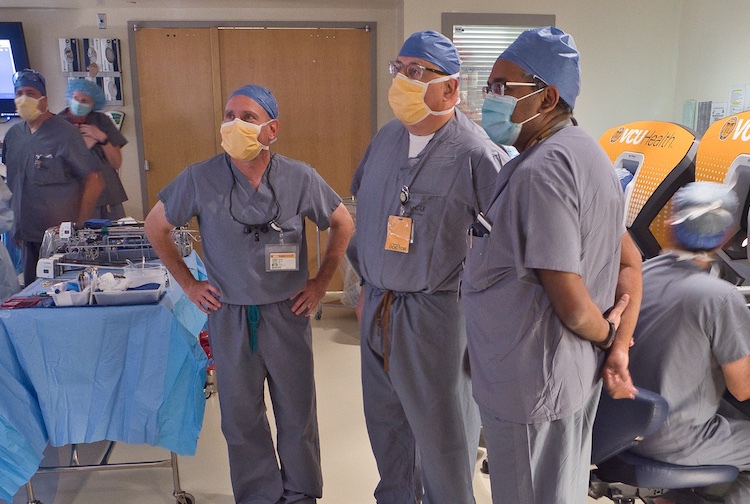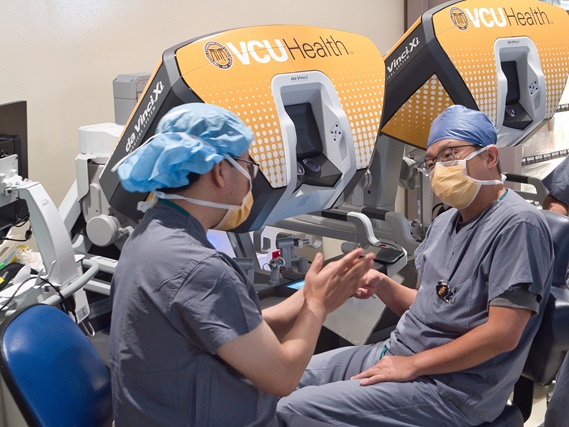
Surgeons at VCU Health Hume-Lee Transplant Center are using an innovative, less-invasive robotic liver procurement procedure to expand the pool of eligible living liver donors. As the number of people registered and waiting for a liver nears 11,000, this represents a critical breakthrough in matching patients needing an organ transplant with healthy livers.
Hume-Lee Transplant Center is the only center on the East Coast actively offering robotic hepatectomies – the surgical removal of portions of living donors’ livers – after becoming the third U.S. center to successfully perform this innovative surgery. The center performed its first fully robotic hepatectomy in April 2023.
“The Hume-Lee Transplant Center has a legacy of surgical innovations to improve the experience and outcomes for donors and recipients alike,” said David Bruno, M.D., interim chair of Hume-Lee and Virginia Commonwealth University School of Medicine’s Division of Transplant Surgery. “Our goal remains to find the best match for every patient who needs an organ, and our advancements with robotic liver procurement ease some physical burdens on living donors as they make lifesaving and life-changing decisions.”
Because robotic surgery is less invasive, donors can recover quicker with less pain and less scarring, meaning they can more quickly return to normal activities while the remaining portion of their liver regenerates. One major advantage is that surgeons can avoid making a significant abdominal incision which cuts through muscle. That muscular healing is often the toughest part of a donor’s recovery. Robotic surgery moves the main incision below an individual’s belt line.
In late July, Hume-Lee hosted global liver transplant pioneer Gi Hong Choi, M.D., who has performed more than 150 robotic procurement surgeries, to provide hands-on robotic expertise in more complex cases and to enhance team members’ skills. Using a robotic surgical system, Choi partnered successfully with Hume-Lee liver transplant surgeons on two hepatectomies on donors who didn’t meet conventional criteria; one with a larger than normal liver and one with abdominal scarring from a previous surgery. The robotic system’s enhanced precision allows surgeons to adapt to complex anatomical conditions – including those two cases – that previously excluded would-be donors from eligibility, while continuing to perform safe and effective procedures.
“VCU has very active transplant surgeons who will have widespread success with the robotic living liver donor program,” said Choi, professor of surgery at Yonsei University in South Korea. “There is pioneering work being done here … to provide minimally invasive surgery for donors with great expected outcomes.”
Last fall, Hume-Lee’s Vinay Kumaran, M.D., living liver donor surgical director, and Seung Duk Lee, M.D., associate surgical director of liver transplant, traveled to South Korea, where living-donor transplants are more common. There, the surgeons observed operations to capture insights on leveraging a robotic system to procure a portion of a liver from a living donor.
With a surgeon at the controls, the robot’s four arms carry a camera scope and instruments into the body via four small punctures to remove a part of the living donor’s liver. The system provides magnification of up to 10 times the human eye, pinpointing accuracy and stability in moving tissue and making incisions. Due to the complexity of the donor recipient’s procedure, liver implantation surgery is still commonly performed through traditional open surgery.
Choi noted that the robotic function allows surgeons to overcome two limitations of laparoscopic surgery: the so-called “fulcrum effect,” where the device’s motion is more restricted at the incision, and limited movement within the very compact area that houses the liver. The organ also must be handled precisely to protect its complex and delicate vascular anatomy.
“There was great collaboration between the VCU Health doctors during the surgery. We discussed the patient’s anatomy and how to standardize the procedure with complex cases, which is a very important path,” Choi said. “With full support of the hospital leaders, active surgeons and the entire transplant team, VCU Health is in a very important position to lead this type of advanced robotic surgery for living donors.”

Global liver transplant pioneer, Gi Hong Choi, M.D., and Seung Duk Lee, M.D., associate surgical director of liver transplant at VCU Health Hume-Lee Transplant Center, briefly stop to discuss the next steps of the fully robotic living donor liver surgery. (VCU Health Hume-Lee Transplant Center)
For recipients, particularly those in failing health, living donors can provide timelier access to an organ, rather than waiting longer for a deceased liver. Too often, patients who opt for a deceased liver might be too frail for a transplant once they are near the top of the list. According to the United Network for Organ Sharing, about 9,000 liver transplants occur each year, leaving a shortage of organs for every patient who needs one.
“By and large, most living donors are given to help a relative, which are often the best medical matches for recipients,” said Bruno, who implanted both procured organs from the robotic hepatectomies where Choi assisted. “The more we expand the criteria for those who can donate, the faster we can make those matches.”
VCU Medical Center has been performing robotic surgeries since 2014, when it launched this surgical system. Long a leader in transplant innovation, Hume-Lee established a minimally invasive surgery division in July 2019. In 1998, VCU Health became one of the first hospitals to perform a living-donor liver transplant.
Virginia is one of 25 states with medical centers that perform living donor liver transplants, according to the Organ Procurement and Transplantation Network.

